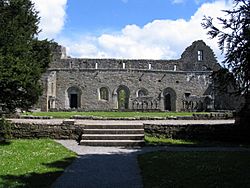Cong Abbey facts for kids

View of the remains of Cong Abbey
|
|
| Monastery information | |
|---|---|
| Order | Augustinian canons |
| Established | 7th century (original structure), 12th century |
| Disestablished | 1542 |
| Diocese | Archdiocese of Tuam |
| People | |
| Founder(s) | Saint Feichin |
| Architecture | |
| Heritage designation | National Monument |
| Style | early Gothic |
| Site | |
| Location | Cong, County Mayo, Ireland |
| Coordinates | 53°32′25″N 9°17′12″W / 53.54028°N 9.28667°W |
| Visible remains | church building, cloisters, monks' fishing house |
| Public access | Yes |
Cong Abbey, also called the Royal Abbey of Cong, is an amazing old building in Cong, Mayo, Ireland. It's in the province of Connacht. Most of the abbey's ruins are from the 1200s. People say it has some of the best medieval (Middle Ages) church architecture in all of Ireland.
Contents
History of Cong Abbey
Early Beginnings and Rebuilding
A church was first built here in the early 600s. It was supposedly founded by Saint Feichin. Later, in 1114, a building on the site was destroyed by fire. About 20 years later, Turlough Mor O’Connor, who was the High King of Ireland, helped rebuild the abbey.
In 1137, attackers from Munster destroyed the buildings again. But King Turlough quickly rebuilt them. The abbey was then officially restarted as an Augustinian monastery in 1138. This was one of the first Augustinian settlements in the south of Ireland.
The Last High King and the Cross of Cong
In 1198, King Turlough's son, Ruaidrí Ua Conchobair (Rory O'Connor), built new parts of the abbey. Rory O'Connor was the last High King of Ireland. He lived the last 15 years of his life at Cong Abbey. He died there and was first buried at the abbey. Later, his body was moved to Clonmacnoise.
The O'Duffy family was also very important to Cong Abbey. They were connected to it from 1097 to 1501. Records show that in 1150, Muireadhach Ua Dubhthaigh, who was the Archbishop of Connacht, died at Cong when he was 75. His name is carved on the famous Cross of Cong.
Attacks and Restoration
In 1203, a Norman knight named William de Burgh attacked Cong. The abbey had to be rebuilt once more. In 1307, the abbey was rebuilt again and dedicated to St Mary.
Cong Abbey was closed down sometime after 1542. After that, it slowly fell into ruins. The last person to be called abbot was Father Patrick Prendergast. He was the local priest from 1795 until he died in 1829. He helped save the important Cross of Cong. After he died, the cross was bought by James MacCullagh for the Royal Irish Academy.
The first time the abbey was restored was in 1855. This work was started by Benjamin Guinness. He had bought the nearby Ashford Castle a few years earlier in 1852.
Architecture of Cong Abbey
Amazing Medieval Design
The ruins of Cong Abbey are known for their beautiful early Gothic architecture. This style was popular in the 1200s. The main church and parts of the cloister (where monks worked and prayed) are from the early 1200s.
The north doorway of the church is very detailed. So are the doorways leading from the cloister into the eastern part of the monastery. These parts might even be older than the attack by William de Burgh.
The Chapter House
One special doorway has two lovely windows on either side. This leads into the chapter house. This was a very important room for the monks. They met here every day to discuss the monastery's business. They also read a part of their rules and confessed their sins publicly. The stone carvings at the abbey are some of the best in Ireland. They show connections to French art styles from that time.
The Monks' Fishing House
On the abbey grounds, you can also find a unique monks' fishing house. It was probably built in the 1400s or 1500s. It sits on a small island in the River Cong, which flows towards Lough Corrib. The house is built on a platform of stones. The river flows right underneath its floor through a small arch.
There's a trapdoor in the floor where the monks might have kept their fresh fish. Local stories say that a rope connected the fishing house to the monastery kitchen. This way, the cook would know when fresh fish had been caught!
Cong Abbey Today
Today, Cong Abbey is a national monument. It is looked after by the Commissioners for Public Works. This means it is protected and cared for so people can continue to visit and learn about its history.
Gallery









